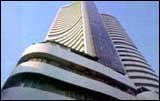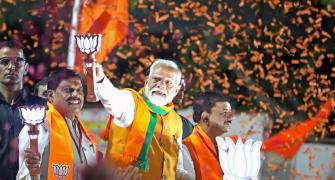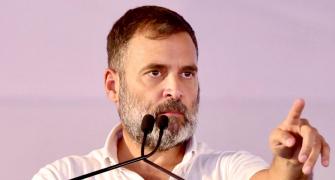 Somebody calculated that there is a better chance of guessing the right number in a Playwin lottery than correctly guessing returns from the stockmarket.
Somebody calculated that there is a better chance of guessing the right number in a Playwin lottery than correctly guessing returns from the stockmarket.
But it isn't necessary to guess the exact returns in order to make money from equities. Being right about the overall direction is good enough.
Technical calculations suggest that the market could move up in calendar 2003.
The charts look good, so does the macroeconomic performance in October-December 2002. Interest rates are low. Plus, there is a recurrent pattern in Indian markets that suggests 2003 could be good for investors.
Balanced against this positive outlook is the US-Iraq situation and slow recovery of the global economy.
If the Americans invade Iraq it could have unpredictable consequences. Even the fear of US invasion has kept oil prices high.
Last year saw little volatility in Indian markets and a marginally positive return of around 3 per cent for the Nifty and twice that for the Sensex.
The annual high of Nifty was at 1205 (Sensex at 3758) on February 27, 2002, just before a lacklustre budget dashed investors' hopes. The annual low came in late October with Nifty at 920 (Sensex at 2828).
With an average value of 1056 for Nifty and a standard deviation of 68 points, this is a very narrow range. But the returns were a lot better than in calendar year 2001 (minus 20 per cent) and 2000 (minus 23 per cent).
That's two bad years, followed by a marginal recovery. Going back to the inception of the Sensex in 1979, two negative years in succession is unusual.
There isn't a single period of four years' duration without at least one delivering substantial positive returns. Thus on previous performance, we can hope that 2003 will be positive.
Strictly on the charts, the prognosis is positive. The market pulled above its own 200 DMA in the last quarter and has stayed above that benchmark. This is a reliable signal of a new bull market.
The moving average signal is reinforced by the breach of a falling minus 40 degree trendline that connected successively lower tops between February and November.
The recovery has come on decent volumes, which suggests that it's based on rising demand and, hence, sustainable.
Between June and December, a bullish saucer has formed. The minimum upside projections are about 1190 for 2003.
There is strong resistance at around 1200. If the Nifty climbs past 1200, the minimum upside target could be 1450. That is, the market should rise between 10 and 33 per cent in 2003 if we've read the direction right. At least part of that rise will come before the Budget unless Iraq is attacked.
Suppose Iraq or a poor budget (or both) wipes out the bulls? The downside is 950 -- there is strong support at 950-960. Barring nuclear war with Pakistan or something like that, the market should stay above 950 -- a scenario of 12 per cent loss.
It is likely that outperformance could come from two sectors. IT is coming out of a trough and banking/financial sector stocks are in a strong bull run.
Oil is a big question mark -- there will be volatility here but we don't know the direction. The Iraq situation will affect global prices and the speed of divestment of public sector units will affect domestic sentiments. If India's economy does show strong overall recovery, there will be turnarounds in many other sectors. -- Devangshu Datta, independent analyst.
'Sensex could rise to 4500'
The year 2002 having gone by, there is a lot of expectation built around the new year. The markets have seen a revival in sentiments and the higher turnover seems to indicate that retail participation seems to be returning to the markets.
As the enclosed chart suggests, the falling tops and bottoms formation which was seen since May 2000 has now been broken, at least on the falling bottoms count.
The bottom made in July and November 2002 was significantly higher than the September 2001 bottom.
Moreover, the Nifty is trading above its downward sloping channel of 30-month duration and in the bargain has also surpassed the 52-week SMA (simple moving average).
These are signs of strength and hold promise that 2003 will be a better time for the investing community than last year.
Where an absolute confirmation is concerned, I would like to see the 1206 previous top being surpassed and then the falling tops / bottoms formation would be conclusively broken and the long term trend of the markets reversed.
The oscillators are largely supportive of the rally and imbibe bullish confidence. Once the Nifty 1206 levels are surpassed, I would expect the markets to stabilise and consolidate for a few months before a fresh move starts.
The technology sector is likely to regain its lost ground led by frontline counters like Infosys, Wipro and Satyam Computer.
Among old economy stocks, Telco, Tisco, Reliance and Ranbaxy remain market out-performers with a high relative strength vis-à-vis the benchmark indices.
What is noteworthy is the fact that the markets will be evolving rapidly and, therefore, the kind of rally that market players have seen in the last five years may not be witnessed in the real sense of the word.
There is some hot money (hedge funds ) in the markets and the movements will therefore be fast and small. It is going to be a year for the savvy and nimble-footed investor.
Unless every investor has a clear gameplan in place, he/she runs the risk of compounding losses in the coming year. The year will clearly belong to the derivatives segment which will hog volumes and trader interest. -- Vijay Bhambwani, CEO, BSPLindia.com.
'Markets will look up'
What do the charts foretell for the new year 2003 that has just begun? 2003 is an unknown country, waiting to be explored. But the past as revealed by charts provides clues to the shape of things to come.
The first question that arises in an investor's mind is whether the 2595 low of September 2001, is behind us. In the enclosed weekly Sensex chart we have five descending trendlines from the all time high of 6150.
These are called fan lines because they resemble a fan. The first one joining the 6150 high to the 5542 is the one most to the left. The downward gradient is sharpest.
As the market falls, the downward gradient of each succeeding new trendline becomes less acute.
We thus have the second one from 6150 to 5058, and the third from 6150 to 4790. The fourth fan line is from 6150 to the 4462 high of February 2001.
It is to be noted that in all these four fan lines, when the Sensex crossed it, to define a following one, it has retraced itself below the fan line that it had crossed.
In the case of the fifth trendline from 6150 to the previous Budget high of 3758 in February 2001, the Sensex has for 11 month's consolidated in the area between 3758 and the 2828 low and then has broken out across it to touch the 3413 high of this month.
This incidentally is at the 61.8 per cent Gann correction level of the 3758-2828 fall. Given the consolidation preceding the crossover of the fifth trendline, a reversion to 2595 level is ruled out.
Now comes the question of a reversal below the October 2002 low of 2828. This level is at the trendline from the 1980 low of the year 1993, parallel to the trendline joining the 4546 high of 1992 to the 6150 peak of 2000.
Secondly, the month of November 2002 is a milestone in the Fibonacci series of monthly periods for important technical landmarks. Hence, a return to 2828 is highly improbable.
The Sensex has in the rise from 2828 left four gaps. A gap occurs when the low of a day is higher than the high of the immediately preceding day. The first of these is at 2991, being a runaway gap. The second is at 3037. The market tends to return to fill these sooner or later.
Hence, an intra-year return to these levels is possible. On the upside the Sensex is hesitant on the brink of a crossover across 3413, which, when it happens, could make it test 3758, if not higher levels in the 3950-4050 region.
The larger resistance would be in the 4450-4650 area where there is resistance from previous peaks.
Thus, the Sensex in the year 2003 could see an upside of 4500-4650 with a lower bound of 3000. -- Baldev Chawla, Technical analyst, Motilal Oswal Securities.







